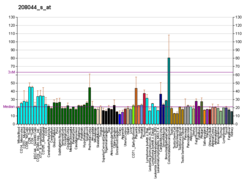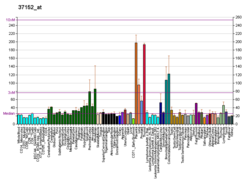Function
PPAR-delta is a nuclear hormone receptor that governs a variety of biological processes and may be involved in the development of several chronic diseases, including diabetes, obesity, atherosclerosis, and cancer. [7] [8]
In muscle PPARD expression is increased by exercise, resulting in increased oxidative (fat-burning) capacity and an increase in type I fibers. [9] Both PPAR-delta and AMPK agonists are regarded as exercise mimetics. [10] In adipose tissue PPAR-β/δ increases both oxidation as well as uncoupling of oxidative phosphorylation. [9]
PPAR-delta may function as an integrator of transcription repression and nuclear receptor signaling. It activates transcription of a variety of target genes by binding to specific DNA elements. Well described target genes of PPARδ include PDK4, ANGPTL4, PLIN2, and CD36. The expression of this gene is found to be elevated in colorectal cancer cells. [11] The elevated expression can be repressed by adenomatosis polyposis coli (APC), a tumor suppressor protein involved in the APC/beta-catenin signaling pathway. Knockout studies in mice suggested the role of this protein in myelination of the corpus callosum, epidermal cell proliferation, and glucose [12] and lipid metabolism. [13]
This protein has been shown to be involved in differentiation, lipid accumulation, [14] directional sensing, polarization, and migration in keratinocytes. [15]
Role in cancer
Studies into the role of PPAR-delta in cancer have produced contradictory results. Although there is some controversy, the majority of studies have suggested that PPAR-delta activation could result in changes that are favorable to cancer progression. [16] PPAR-delta favours tumour angiogenesis. [17]
Ligands
PPAR-delta is activated in the cell by various fatty acids and fatty acid derivatives. [7] Examples of naturally occurring fatty acids that bind with and activate PPAR-delta include arachidonic acid and certain members of the 15-hydroxyicosatetraenoic acid family of arachidonic acid metabolites including 15(S)-HETE, 15(R)-HETE, and 15-HpETE. [20] Several high affinity ligands for PPAR-delta have been developed, including GW501516 and GW0742, which play an important role in research. In one study utilizing such a ligand, it has been shown that agonism of PPARδ changes the body's fuel preference from glucose to lipids. [21] Initially, PPAR-delta agonists were considered promising therapies as an exercise mimetic that could treat metabolic syndrome, but later on more evidence was uncovered about their possible pro-cancer effects. [16]
The atypical antidepressant Tianeptine has been shown to be a high-efficacy PPAR-delta agonist. [22]
Agonists
Although its drug development was discontinued due to animal studies suggesting an increased risk of cancer, GW501516 has been used as a performance enhancing drug. [25] It and other PPAR-delta agonists are banned in sports. [26] [27]
This page is based on this
Wikipedia article Text is available under the
CC BY-SA 4.0 license; additional terms may apply.
Images, videos and audio are available under their respective licenses.














